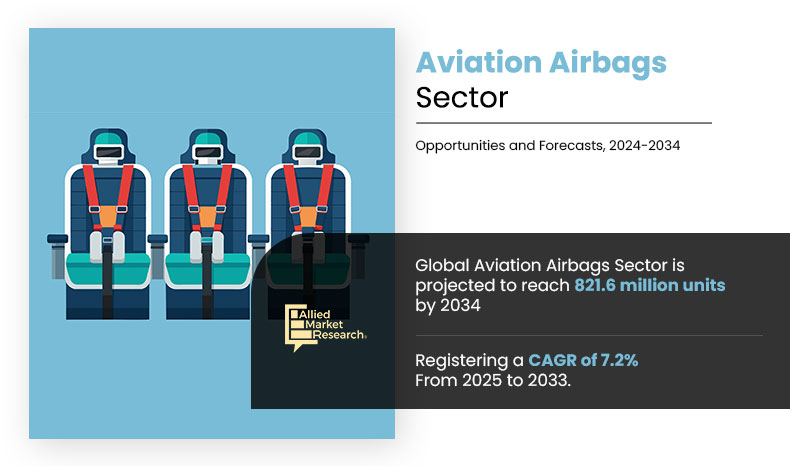Volume Insights Strategic Overview

Allied Market Research announces the release of its comprehensive analysis of the global aviation airbags sector. Designed to enhance occupant safety, comfort, and protection during flight, aviation airbags are becoming a crucial component in both commercial and private aviation. These airbag systems are essential in mitigating injuries and ensuring enhanced safety in various aircraft seating configurations. As the demand for advanced safety features, especially in premium cabins, continues to rise, aviation airbags are becoming an integral part of the evolving global aviation safety landscape.
The report highlights the increasing need for aviation airbags in both new aircraft and retrofit programs for existing fleets. With the rising focus on passenger safety, regulatory advancements, and growing consumer expectations, the aviation airbags sector is expected to experience steady growth. Factors driving this growth include the incorporation of airbags in premium economy and business-class seating, as well as the retrofitting of airbag systems in existing aircraft fleets to comply with emerging safety regulations.
The market has seen notable advancements in airbag technologies, with manufacturers focusing on lightweight, compact, and energy-efficient airbag modules that meet the demands of modern aircraft. The rise in airbag adoption is also linked to evolving airline and passenger preferences for increased safety and comfort. As the global aviation industry grows and safety regulations become stricter, the demand for aviation airbags is set to continue its upward trajectory.
The global aviation airbags market volume was valued at 426.9 million units in 2024 and is projected to reach 821.7 million units by 2034, registering a CAGR of 7.2% during the forecast period. This growth is driven by innovations in airbag designs, integration with smart safety systems, and expanding regulatory frameworks across key aviation regions.
Regional Aviation Airbags Sector Volume Growth
North America dominated the automotive radar sector volume share with 35.4% share in 2024, and is expected to grow at 6.2% CAGR, while Asia-Pacific, Europe, and LAMEA exhibit strong growth at 8.8%, 7.0%, and 6.6% CAGR, respectively, driven by regional urban mobility trends and sustainability efforts.
The regional analysis highlights notable variations in adoption trends and sector volume growth potential across the globe. North America dominated the aviation airbags sector volume share, accounting for 35.4% of total installations in 2024, and is expected to grow at a CAGR of 6.2%, supported by the region's strong safety regulations, technological innovations, and the rising demand for enhanced passenger protection systems in both commercial and private aviation.
Asia-Pacific, driven by increasing air travel demand, rapid fleet expansion, and rising safety standards, is anticipated to experience strong growth, with a projected CAGR of 8.8%. Countries like China, India, and Japan are contributing significantly to this growth, fueled by the increasing adoption of airbag systems in both regional and international aircraft.
Europe, led by markets such as Germany, France, and the UK, is expected to grow at a CAGR of 7.0%, bolstered by stringent EU aviation safety regulations and ongoing advancements in passenger safety technology. The region’s focus on innovation in aviation and air safety will continue to play a key role in the sector’s expansion.
The LAMEA region, benefiting from increasing focus on urban mobility, rising passenger demand, and investments in next-generation aircraft, is projected to grow at a CAGR of 6.6%. Key countries such as the UAE, Brazil, and South Africa are contributing to this growth, driven by evolving aviation regulations and growing investments in air safety systems.
Aviation Airbags Sector Volume Growth, By Region, 2024-2034 (Million Units)
Region | 2024 | 2029 | 2034 | CAGR (2025–2034) |
North America | 151.0 | 180.0 | 265.4 | 6.2% |
Europe | 127.5 | 157.3 | 240.5 | 7.0% |
Asia-Pacific | 106.6 | 143.9 | 239.3 | 8.8% |
LAMEA | 41.9 | 50.9 | 76.6 | 6.6% |
Total | 426.9 | 532.1 | 821.7 | 7.2% |
Source: AMR Analysis
Aviation Airbags Country Sector Sales
The U.S. and Germany continue to lead the aviation airbags sector in volume growth, projected to reach 208.94 million and 85.5 million units respectively by 2034, growing at a CAGR of 5.7% and 7.1%. Meanwhile, China (7.5% CAGR) and France (7.5% CAGR) are emerging as high-growth markets, driven by increasing air travel demand, rising emphasis on passenger safety systems, and regulatory pressure for enhanced in-flight safety infrastructure.
The report identifies the U.S. and Germany as the largest contributors to the aviation airbags sector in terms of volume growth.
The U.S., supported by its expansive commercial aviation fleet, mature aerospace manufacturing capabilities, and high safety compliance standards, is expected to reach 208.94 million units by 2034, growing at a CAGR of 5.7%. Germany, backed by its strong aerospace engineering base, focus on innovation in in-flight safety systems, and strategic collaborations with global aircraft OEMs, is set to grow to 85.5 million units by 2034 at a CAGR of 7.1%, leading growth within the European region.
China, driven by its rapidly growing air passenger traffic, government-supported aviation infrastructure expansion, and increasing adoption of safety-enhancing cabin technologies, is expected to reach 80 million units by 2034, growing at a CAGR of 7.5%. France, supported by a strong aerospace legacy, advancements in seat-integrated safety technologies, and rising aircraft production volumes, is expected to reach 62.21 million units, registering a CAGR of 7.5%.
Other parts of Europe, grouped as Rest of Europe—including the UK, Italy, and Spain—are collectively expected to reach 40.05 million units by 2034, growing at a CAGR of 5.3%, supported by regulatory mandates and gradual modernization of cabin safety features across commercial fleets.
In Asia-Pacific, countries grouped under Rest of Asia-Pacific, such as South Korea, Australia, and Southeast Asian nations, are emerging as high-potential markets, projected to grow to 69.39 million units by 2034 at a CAGR of 9.0%, owing to expanding regional air networks, increased airline investments in safety upgrades, and growing commercial aviation activity.
Automotive radar Sector Volume Share, By Country, 2024-2034 (Million Units)
Country | 2024 | 2029 | 2034 | CAGR (2025-2034) |
U.S. | 124.56 | 145.12 | 208.94 | 5.7% |
Germany | 44.57 | 55.46 | 85.5 | 7.1% |
China | 40.21 | 51.21 | 80 | 7.5% |
France | 31.32 | 39.68 | 62.21 | 7.5% |
Rest of Asia-Pacific | 30.35 | 41.35 | 69.39 | 9.0% |
Rest of Europe | 24.68 | 28.33 | 40.05 | 5.3% |
Source: AMR Analysis
Aviation Airbags Market Drivers & Trends
The report highlights a global push for lightweight and sustainable airbag systems that align with broader aviation goals for fuel efficiency and reduced emissions. Innovations such as bio-based airbag materials, low-weight inflators, and AI-enabled sensor-trigger mechanisms are shaping the future of aircraft safety systems.
With passenger expectations evolving toward personalized in-flight experiences, OEMs and airlines are also prioritizing customized seat-integrated airbags, especially in premium cabins. In parallel, business jets and VIP-configured aircraft are incorporating advanced occupant protection systems as standard features, contributing to aftermarket growth.
Moreover, increasing aircraft deliveries, fleet expansion in emerging economies, and stringent crashworthiness certification requirements are reinforcing the importance of advanced safety components, positioning airbags as a critical part of the aviation safety and compliance ecosystem.
Key Highlights by Stakeholders
Ashwani Ajwani, Vice-President of Allied Market Research, noted, “The aviation industry’s renewed focus on safety, comfort, and sustainability is reshaping cabin protection systems. Aviation airbags are no longer optional add-ons—they are becoming standard features in both commercial and business aviation environments. Our research captures this shift, providing key insights for manufacturers, suppliers, and airline stakeholders aiming to stay ahead in this evolving sector.”
He further added, “Asia-Pacific is poised for transformative growth, while North America remains a stronghold of innovation and regulatory maturity. Europe and LAMEA are also expanding rapidly, underpinned by fleet modernization and greater passenger safety awareness. Our findings underscore the critical role airbags will play in future-ready aircraft designs.”
Aviation Airbags Sector Volume Trends
The report emphasizes the evolving significance of aviation airbags in enhancing onboard passenger safety and aligning with global aviation safety mandates.
Amid growing concerns over in-flight safety and rising demand for improved crash survivability in both commercial and business aviation segments, the market is witnessing a noticeable shift toward lightweight, compact, and energy-absorbing airbag solutions. These innovations are designed to meet strict regulatory frameworks, such as those laid out by the Federal Aviation Administration (FAA) and the European Union Aviation Safety Agency (EASA), while also addressing sustainability by incorporating recyclable materials and advanced deployment systems.
Technological innovations are playing a pivotal role in reshaping the aviation airbags landscape. Recent developments include sensor-integrated airbags, modular seating configurations, and adaptive deployment mechanisms that can tailor inflation patterns based on passenger posture, body mass, and crash severity. These advancements are not only increasing passenger protection but also supporting the broader movement toward intelligent cabin safety solutions—especially in premium economy and business class seating.
The report also delves into the influence of rising global air passenger traffic, growing aircraft fleet modernization initiatives, and a surge in long-haul international flights on the demand for advanced airbag systems. As airlines focus more on passenger well-being and regulatory compliance, the adoption of seat-integrated airbag modules is gaining traction across both narrow-body and wide-body aircraft platforms.
Furthermore, emerging economies, particularly in Asia-Pacific and the Middle East, are investing heavily in new aircraft procurement and enhancing aviation safety infrastructure. These developments, alongside strategic partnerships between OEMs and airbag system providers, are opening new avenues for growth. Industry stakeholders—including component manufacturers, airlines, and MRO providers—are encouraged to utilize insights from this report to capitalize on innovation-driven opportunities, navigate compliance requirements, and strengthen their market positioning in an increasingly safety-conscious aviation ecosystem.
About Allied Market Research
Allied Market Research is a full-service market research and business consulting firm, which provides actionable insights and strategic recommendations to help clients make informed decisions and achieve sustainable growth. For more inquiries, please visit alliedmarketresearch.com


